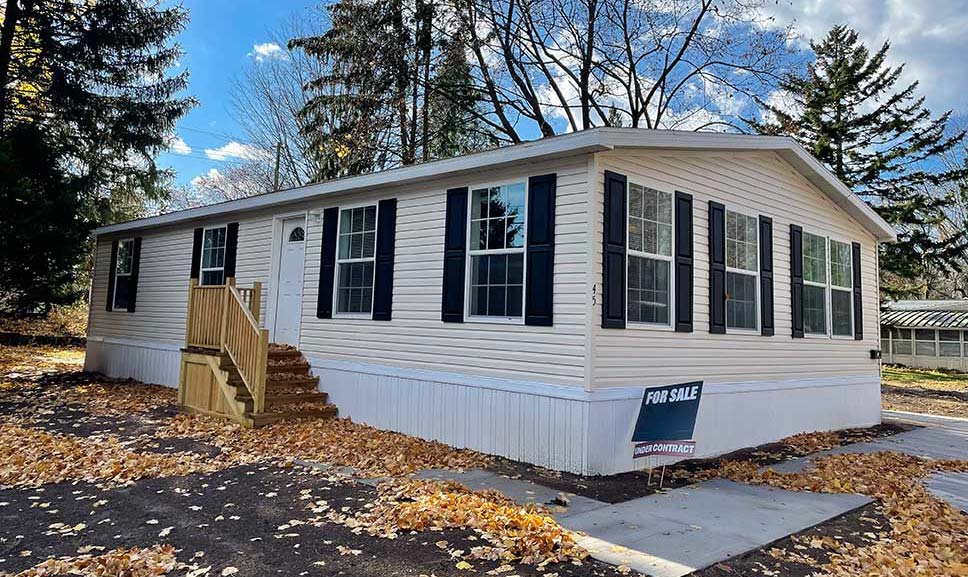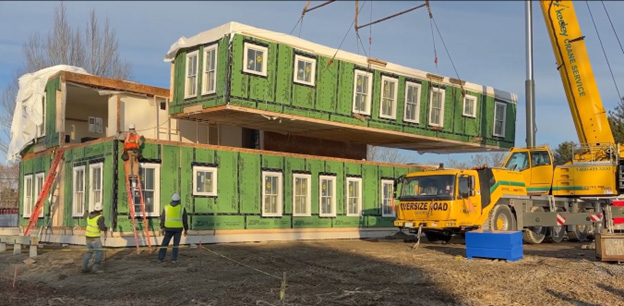- Navigator
- Construction and Utilities
- Real Estate Development and Housing
 As costs for land and stick-built homes climb — with no price relief in sight — alternative home construction models are emerging on the market to fill the affordability void.
As costs for land and stick-built homes climb — with no price relief in sight — alternative home construction models are emerging on the market to fill the affordability void.
Manufactured homes are nothing new in America. Historically and commonly called mobile homes or trailers, the quality of construction significantly improved when the federal government set national construction standards and codes for manufactured homes in 1976. Unlike any other housing construction standards, manufactured homes are the only ones not governed by state and local jurisdictions.
Panelized construction involves producing separate wall units in a controlled, off-site environment. The units are then delivered to the building site on a flatbed truck for the homebuilder’s crew to assemble.
Modular homes are built in whole sections in a factory and delivered to the construction site on trailer trucks. There, they are stitched together and electrical, plumbing, and interior finishes are completed.
So, How Do These Types of Alternative Construction Address Housing Affordability?
Manufactured Homes
Manufactured homes are still the most economical form of housing today. Their construction quality has become more consistent and reliable since the early days of trailer homes. In 2022, the US Department of Housing and Urban Development (HUD) added energy efficiency standards to the construction codes.
There is an increasing push for jurisdictions to remove prohibitions on manufactured homes in single-family neighborhoods. In some rural markets, where prevailing wages are insufficient for stick-built construction, manufactured homes are an apt affordable housing solution.
A social stigma around manufactured homes remains. However, modern manufactured homes can mimic the shapes and finishes of stick-built houses, with porches and siding materials to match the neighborhood.
Because manufactured houses have been an affordable housing option for low-income residents for generations, some of the negative behaviors associated with the stress of poverty have been linked to them. One does not beget the other, though, and proper upkeep standards and enforcement are an easy way to maintain safe, tidy, and peaceful manufactured home neighborhoods.
Take another look at manufactured homes in markets where the numbers don’t work for stick-built houses. A well-planned and managed community could solve a local housing gap.
When affordability is the goal, be mindful of one potential pitfall: In many manufactured home parks, the resident owns the manufactured home, but a private party owns the land. Profiteering landowners could put affordability at risk, most especially after the sale of a park to a new investor.
Panelized Construction
Panelized construction is a niche, premium product that works more like a production accelerator than an efficiency model. These wall panels are built in a factory to suit, and a whole house frame can be stacked onto a flatbed truck.
On the other hand, they don’t come cheap, and if a crane is necessary to unload the truck and position the panels in place while a crew affixes them, that’s a substantial cost not factored into site-built construction.
However, panels can help expedite the construction schedule when buyer demand is high and framing carpenters are in short supply. In cases where delivery to the buyer is a short step and the volume of units sold will be maximized by how quickly the housing can be produced, the efficiency of panel construction could make it financially worthwhile.
Modular Construction
 A crane positions a modular unit on an affordable multiplex project in Madison, ME. Image courtesy of Dooryard.us.
A crane positions a modular unit on an affordable multiplex project in Madison, ME. Image courtesy of Dooryard.us.
Modular construction was once the big bet for replacing site-built houses, but the nuances of modular and stick-built construction have proven that each method has a time and place.
While there is much to love about modular construction, three detractors are:
- The physical feats necessary to transport modular sections to sites, plus the crane costs to lift the sections into place.
- The amount of precise planning that must go into the modular specifications upfront. Errors are harder to correct once the modules are in place.
- The warranty. Once the modules are transported for sometimes hundreds of miles across the state, if a mistake is discovered on-site, the practicality of the modular company fixing it is not realistic.
However, if a homebuilder is buying a tried-and-true model and has a reliable crew on site to complete the finish work, then modular construction can shorten a building schedule from over a year for stick-built to a matter of weeks.
Modular construction can slash carrying costs in a world where time equals money — especially in terms of interest on a construction loan. If the schedule is executed effectively, modular construction can end up being more cost-effective, but it’s the attention to detail that makes or breaks the economics of it.
In short, there is more than one approach to homebuilding than traditional stick-build construction, and these alternate methods might be a good tactic for addressing affordability and supply in your community.
Does your community have enough housing construction to meet demand right now? If not, it might be the local economics of homebuilding. Let Camoin Associates assess the affordability and feasibility of your housing market for you and provide real-world strategies to meet your housing needs when the private sector seems stuck. Contact Robert O’Brien, Senior Housing Specialist, at robrien@camoinassociates.com to get started.
Learn more about our Real Estate Development and Housing Services
📍 Related Articles:





